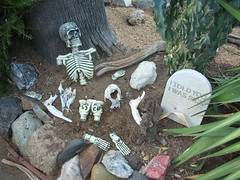 This section could also be called "How to Build a Scare." Most people don't realize how a scare needs to be crafted; the legions of bad horror movies are a testament to that. Relentless attacks on the senses produce stupor, not fright; a true craftsmaster will also prefer to let the audience use imagination to produce a scare rather than showing his hand too early.
This section could also be called "How to Build a Scare." Most people don't realize how a scare needs to be crafted; the legions of bad horror movies are a testament to that. Relentless attacks on the senses produce stupor, not fright; a true craftsmaster will also prefer to let the audience use imagination to produce a scare rather than showing his hand too early.Remember Alien, the first movie? The title creature got very little screen time and, in fact, was not evident for the first half of the movie. What was evident was the disquieting elements: the radio gone silent, the skittering noises, the movement caught out of the corner of the eye. When the audience first saw the facehuggers, they were so keyed up that it was far more frightening than if those creatures had been in view from the start.
As with painting, the white space is important. In this case, it is the calm before the storm. Don't be afraid to let your guests have to wait during an early part of the tour, especially if it is in an area geared to produce disquiet. You could have a bloody antechamber with desperate handprints near the exit and a near-constant dripping sound nearby. You could have a coffin with chains around it. You could have a plain room - but with random scratching coming from the other side of the wall. Such a setup not only gets the guests worried but engages their imaginations - what is that sound supposed to be?
Likewise, save your biggest scares for the end. If you've got a killer with a chainsaw at the beginning, don't be surprised when the guests merely shrug at the cartoony witch near the end. The trick is to lull the guests into thinking that everything is normal and then hit them with a shock or a surprise.
For example, to continue with the Aliens theme, above, the entry could be of a typical space station, with a tour guide willing to show them the new state-of-the-art facility. After pointing out a few things in typical tour-guide fashion, he has to communicate with someone else on the team, who does not answer. (Disquiet.) Then a little skittering noise is heard. The tour guide makes a few calming comments but is obviously disturbed himself. As he leads the group into the next room, he realizes that it is in disarray. (More disquiet.) He realizes that something is wrong and he tries to contact someone else. No answer. He instructs the group to stay where they are and then leaves.
After a minute, more skittering sounds are heard, distinctly moving from one side of the room toward another. The lights flicker. Something moves past the door, too fast to be seen. The tour guide's scream is heard, then laser-style shooting or explosions. The tour guide, considerably worse for wear, shows up and instructs the group to follow him. After passing by some destroyed rooms, the tour guide starts indicating that he feels ill. (You could see that one coming.) His shirt starts jumping, and he points the group on. Heavy footsteps are heard behind. The tour guide screams for the group to run. They do, and then the lights go out.
Again, there is a pause while strange noises happen around them. Then a couple of marines show up with flashlights and urge the group to follow them. As they are hurried past a junction, one of the marines is pulled away abruptly, screaming. The group can barely see something, something big. The other marine points them towards the "escape pod" (possibly an elevator), which the group crowds in. The doors take forever to close, during which time the group can almost see something big coming towards them. The marine shoots, but is pulled down. The doors finally close.
For this narrative, the true shape of the alien is never seen. This is especially good if your creature-building skills are suboptimal. The use of dark is important; people fear what they can't see. And leaving the group alone at points leaves them adrift - they don't know what they are supposed to do, and the confusion adds to the sense of fear. By crafting a story from beginning to end, the sense of control rests firmly with the actors, and the fear inspired when the guests are a part of the narrative is increased.
Next up: Practical Considerations
No comments:
Post a Comment